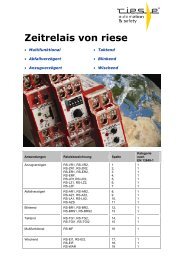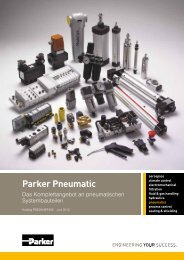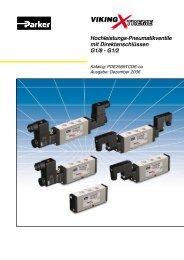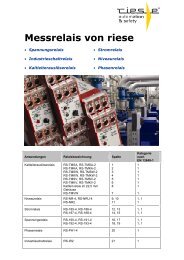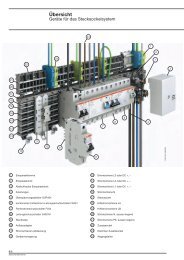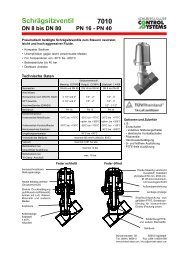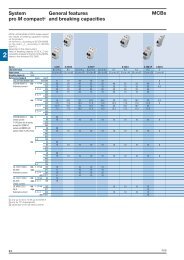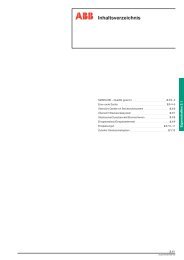Technical details System pro M compact®
Technical details System pro M compact®
Technical details System pro M compact®
- No tags were found...
You also want an ePaper? Increase the reach of your titles
YUMPU automatically turns print PDFs into web optimized ePapers that Google loves.
<strong>System</strong><strong>pro</strong> M compact ®<strong>Technical</strong> <strong>details</strong>Limitation of specifi clet-through energy I 2 tMCBsIUt = 0I 2 1Oscillogram of short-circuitbreaks on two circuit-breakers:1 = traditional non-currentlimiting circuit-breaker2 = current limiting circuitbreakeru B= arc voltage (red)u M= rest voltage (blue)IUI 2K Mt vu BShort-circuit currentred = effective short-circuitcurrent squaredblue = estimated short-circuitcurrent squared (shuntedcircuit-breaker)iK M= maximum values ofsymmetrical componentof short-circuit currentsquaredshaded inred = specifi c let-throughenergy in two casesi Ku MNon-current limiting circuit-breaker2t = 0iK Mt vu Bi Ku MCurrent limiting circuit-breakertttLimitation of specific let-through energyTripping of an installation circuit by circuit-breaker when there is a short-circuit requires a certainamount of time depending on the characteristics of the circuit-breaker and the entity of the short-circuitcurrent. During this period of time, some or all of the short-circuit current fl ows into the installation;the parameter I 2 t defi nes the “specifi c let-through energy”, ie. the specifi c energy that the breakerallows through when there is a short-circuit current Icc during the tripping time t.In this way, we can determine the capacity of a circuit-breaker to limit, ie. break high currents up tothe rated breaking power of the device, by reducing the peak value of the above-mentioned currentsto a value which is considerably lower than the estimated current.This can be achieved using mechanisms which open very rapidly and have the following advantages:- they limit the thermal and dynamic effects both on the circuit-breaker and on the <strong>pro</strong>tected circuit;- they reduce the dimensions of the current-limiting circuit-breaker without reducing breaking capacity;- they considerably reduce ionized gases and sparklers emitted during the short-circuit and thereforethey avoid the danger of ignition and fi res.Irms = perspective simmetrical short-circuit currentMax. withstanding specific let-through energy of cablesSectionmm 2 PVC EPR HEPR50 33,062,500 39,062,500 51,122,50035 16,200,625 19,140,625 25,050,02525 8,265,625 9,765,625 12,780,62516 3,385,600 4,000,000 5,234,94410 1,322,500 1,562,500 2,044,9006 476,100 562,500 736,1644 211,600 250,000 327,1842.5 82,656 97,656 127,8061.5 29,756 35,156 46,010The selection of the cables depends both from the breakers’ specifi c let-through energy and from carrying capacity and voltagedrop of the line.Data of the previous table are referred to the following cables:PVC EPR HEPRFM9 H07RN-F N07G9-KFM9OZ1FTG10OM1N07V-KRG7ORFRORFG7OM1FG7ORDesignationCable’s reference to the standards harmonized Hnational cable recognized by CENELCARated voltage Uo/U 100/100 ≤ Uo/U < 300/300 01300/300 V 03300/500 V 05450/750 V 07750/1000 V 1Insulating materials and non-metallic sheath ethylene-vinylacetate GmineralMpolyvinyl chlorideVConductor’s shape fl exible conductor of a cable for fi xed installation KSome cables on the market are identifi ed with different names according with the designation UNEL 35011.11ABB11/3



